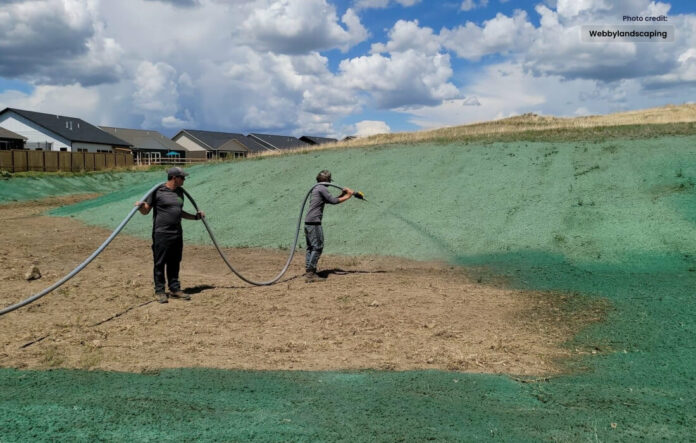Explore the process, benefits, and environmental impact of hydroseeding.
Quick Summary:
Hydroseeding is a planting method that involves spraying a mixture of seeds, mulch, fertilizer, and water onto the ground. It’s commonly use for lawn establishment, erosion control, and re-vegetation projects. The mixture helps protect the seeds and provides them with nutrients and also moisture for optimal growth. Hydroseeding is a cost-effective and efficient way to achieve a lush and healthy lawn.
Introduction
In the quest for sustainable landscaping and efficient revegetation, hydroseeding has emerge as a groundbreaking solution. This innovative technique has gained popularity for its ability to transform barren terrain into flourishing green landscapes in a fraction of the time compared to traditional methods. In this blog, further we will delve into the world of hydroseeding, unraveling the process, benefits, and environmental impact that make it a go-to choice for landscaping professionals and environmental enthusiasts alike.
Understanding Hydroseeding
Hydroseeding, also known as hydraulic mulch seeding or hydro-mulching, is a method of applying a slurry of seed, mulch, fertilizer, and water to the soil. This slurry, often refer to as the “hydroseed mix,” is spray onto the target area using special equipment. The process creates an ideal environment for seed germination and provides a protective layer that enhances soil moisture retention.
The Hydroseeding Process
- Site Preparation: Before hydroseeding, the target area undergoes thorough preparation, including soil testing and any necessary amendments.
- Seed Mix Creation: A customized mix of seeds, mulch, fertilizers, and sometimes tackifiers (binding agents) is prepared based on the specific needs of the project.
- Hydroseeding Application: The hydroseed mix is loaded into a hydro seeder, a specializes machine equipped with a pump and sprayer. The mix is then sprayed evenly across the designated area.
- Germination and Growth: The combination of optimal seed-to-soil contact, protection from erosion, and a nutrient-rich environment promotes rapid germination and robust plant growth.
Benefits of Hydroseeding
- Rapid Results: This accelerates the germination and also establishment of vegetation, resulting in quicker and more consistent coverage compared to traditional seeding methods.
- Erosion Control: The hydroseed mix creates a protective layer that prevents soil erosion, making it an effective solution for slopes, embankments, and also other erosion-prone areas.
- Customization: It allows for the customization of seed mixes, enabling the selection of plant varieties tailored to specific soil conditions and climate.
- Cost-Effective: In many cases, hydroseeding proves to be more cost-effective than traditional seeding or sodding, making it an attractive option for large-scale projects.
Environmental Impact
Hydroseeding boasts several environmental advantages:
- Reduced Erosion: By preventing soil erosion, it helps to maintain the integrity of ecosystems and also minimizes the impact on water bodies downstream.
- Water Conservation: The hydroseed mix enhances water retention in the soil, reducing the need for excessive watering and also promoting sustainable water use.
- Biodiversity Promotion: Tailoring seed mixes to include native plant species supports biodiversity, contributing to the restoration of natural habitats.
Conclusion
Hydroseeding stands as a testament to the fusion of technology and environmental stewardship. As we continue to seek sustainable solutions for landscaping and land restoration, it emerges as a powerful tool capable of transforming desolate landscapes into vibrant, biodiverse ecosystems. Whether for erosion control, reclamation projects, or simply creating a lush lawn, hydroseeding is proving to be a green revolution worth embracing.




